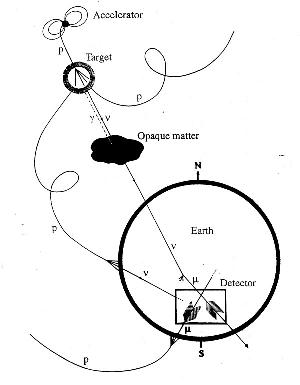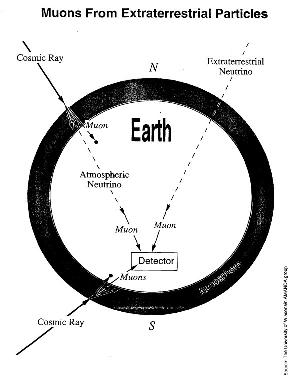Physics behind the experiments
![]()
 AMANDA
AMANDA SPASE
SPASE RICE
RICE GASP
GASP The earth is under a continuous shower of atomic and subatomic particles from space
(cosmic rays). A lot of
these particles are neutrinos or muons. Muons are a kind of heavy electron, that means their
mass is bigger than the electron mass and they have one negative elementary charge. Charged particles,
of course are easy to detect, because they easy interact with matter. Fortunately
when these neutrinos we are looking for have an interaction with matter, mainly muons are
created. So if one of these
interaction happens close to the detector we can detect the muon and so indirectly the
neutrino. The bad side about this is that there are a lot of muons in the cosmic rays, that
have a different origin and are not caused by the interaction of neutrinos with matter.
The earth is under a continuous shower of atomic and subatomic particles from space
(cosmic rays). A lot of
these particles are neutrinos or muons. Muons are a kind of heavy electron, that means their
mass is bigger than the electron mass and they have one negative elementary charge. Charged particles,
of course are easy to detect, because they easy interact with matter. Fortunately
when these neutrinos we are looking for have an interaction with matter, mainly muons are
created. So if one of these
interaction happens close to the detector we can detect the muon and so indirectly the
neutrino. The bad side about this is that there are a lot of muons in the cosmic rays, that
have a different origin and are not caused by the interaction of neutrinos with matter.
 Our aim is it to look for areas in the sky where we got a lot of neutrinos from and find
correlations with astronomical objects.
Our aim is it to look for areas in the sky where we got a lot of neutrinos from and find
correlations with astronomical objects.